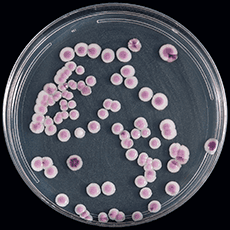
Get A Testing Quote
Candida parapsilosis
STRUCTURE AND PHYSIOLOGY
Candida parapsilosis is commonly found in a unicellular, budding state but also has the ability to form pseudohyphae causing it to look dimorphic. When plated on a dextrose plate, C. parapsilosis will form white, creamy, shiny colonies made up of cylindrical cells. For the yeast phenotype colonies will appear smooth, and for the pseudohyphae phenotype the colonies will appear concentric. C. parapsilosis metabolizes large molecules via oxidative phosphorylation and fermentation by using extracellular enzymes to breakdown large molecules allowing them to be absorbed.
TRANSMISSION AND DISEASE
This fungus can cause sepsis, endocarditis, endophthalmitis, fungemia, peritonitis, and arthritis. C. parapsilosis is easily spread between susceptible populations and is often found on prosthetic devices, catheters and other medical tools handled by healthcare professionals. Their resistance to disinfectants is enhanced through its ability to create biofilms over these medical devices. In turn, this organism results in post-surgical complications and premature death in susceptible populations with neonatal, intensive care, and immunocompromised patients at the highest risk for contracting an infection.
REFERENCES
Trofa, D., Gácser, A., & Nosanchuk, J. D. (2008). Candida parapsilosis, an Emerging Fungal Pathogen. Clinical Microbiology Reviews, 21(4), 606–625.
Neji S, Hadrich I, Trabelsi H, Abbes S, Cheikhrouhou F, Sellami H, Makni F, Ayadi A. 2017. Virulence factors, antifungal susceptibility and molecular mechanisms of azole resistance among Candida parapsilosis complex isolates recovered from clinical specimens. Journal of Biomedical Science. 24(67).
Pereira L, Silva S, Ribeiro B, Henriques M, Azeredo J. 2015. Influence of glucose concentration on the structure and quantity of biofilms formed by Candida parpsilosis. FEMS Yeast Research. 15(5).
Turner, S., & Butler, G. (2014). The Candida pathogenic species complex. Cold Spring Harbor Perspectives in Medicine, 4(9).
Image from: Identification of Candida auris | Candida auris | Fungal Diseases | CDC
Share

